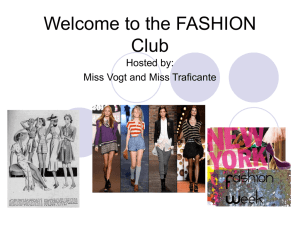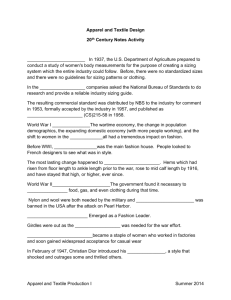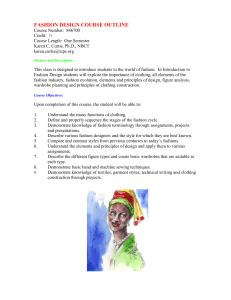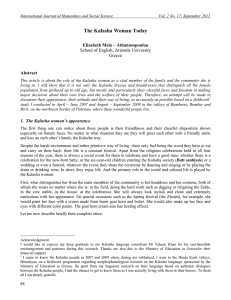Sustainability in Kalash Textile and Fashion
advertisement
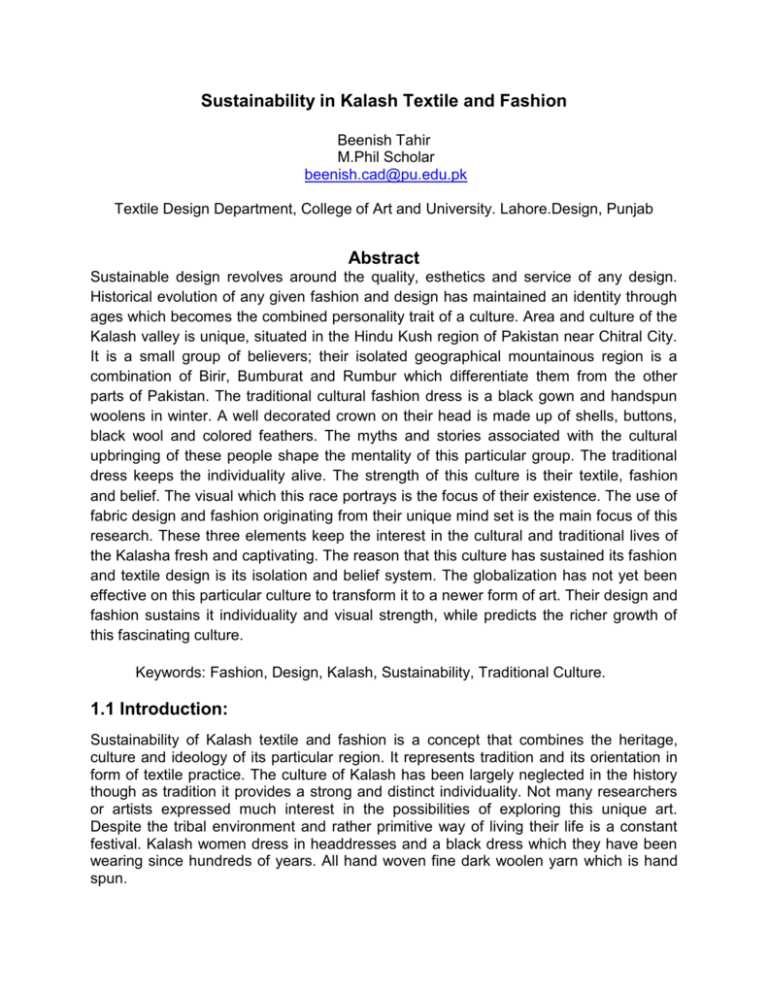
Sustainability in Kalash Textile and Fashion Beenish Tahir M.Phil Scholar beenish.cad@pu.edu.pk Textile Design Department, College of Art and University. Lahore.Design, Punjab Abstract Sustainable design revolves around the quality, esthetics and service of any design. Historical evolution of any given fashion and design has maintained an identity through ages which becomes the combined personality trait of a culture. Area and culture of the Kalash valley is unique, situated in the Hindu Kush region of Pakistan near Chitral City. It is a small group of believers; their isolated geographical mountainous region is a combination of Birir, Bumburat and Rumbur which differentiate them from the other parts of Pakistan. The traditional cultural fashion dress is a black gown and handspun woolens in winter. A well decorated crown on their head is made up of shells, buttons, black wool and colored feathers. The myths and stories associated with the cultural upbringing of these people shape the mentality of this particular group. The traditional dress keeps the individuality alive. The strength of this culture is their textile, fashion and belief. The visual which this race portrays is the focus of their existence. The use of fabric design and fashion originating from their unique mind set is the main focus of this research. These three elements keep the interest in the cultural and traditional lives of the Kalasha fresh and captivating. The reason that this culture has sustained its fashion and textile design is its isolation and belief system. The globalization has not yet been effective on this particular culture to transform it to a newer form of art. Their design and fashion sustains it individuality and visual strength, while predicts the richer growth of this fascinating culture. Keywords: Fashion, Design, Kalash, Sustainability, Traditional Culture. 1.1 Introduction: Sustainability of Kalash textile and fashion is a concept that combines the heritage, culture and ideology of its particular region. It represents tradition and its orientation in form of textile practice. The culture of Kalash has been largely neglected in the history though as tradition it provides a strong and distinct individuality. Not many researchers or artists expressed much interest in the possibilities of exploring this unique art. Despite the tribal environment and rather primitive way of living their life is a constant festival. Kalash women dress in headdresses and a black dress which they have been wearing since hundreds of years. All hand woven fine dark woolen yarn which is hand spun. The present research will highlight the ways in which Kalash textile and fashion has sustained and maintained its presence and individuality. The focus is to explore the Kalash textile and fashion which has embodied the character and essence of the people generation after generation. This study will help to open new perspectives onto the history and theory. Kalash textile surfaces, their qualities such as design, technique and sustainability are an important part of textile language, but have not yet been studied systematically in the local context. Most of the decorative symbols used in Kalash textile have their origin in primary textile design disciplines. Visual studies will validate the place of Kalash design by tracing its history, its individuality and prospective for further implementation. Figure 2: Tracing textile design historically through old and young generation. The relationship between textile fashion and design is an embryonic one. The current research is the attempt to investigate the Kalash textile design in considerable depth, by examining the ideas, descriptions, practice and implementation used in it. 1.2 Background: The Japanese writer for trade magazines, publisher and photo magazines wrote briefly on the significance of Kalash culture and its artistic expression. According to Wada, Kalasha (people of Kalash) are tribal people with very less to go about their daily life yet their lives are a festival through out the year. “Social and religious activities take place at the level of entire community, or at the level of the clan… because of this orientation toward “collectivism” (clan and community) and rigid long standing traditional socio-religious practices, individual responsibility, independence and individual creativity is almost unknown.” (Wada, 2005) What Wada is expressing in these lines are the closely knitting connection among the community which keeps it close to its origins, her approach is more toward the day to day life of the Kalasha’s. This provides an insight into the life of Kalash people which shapes its textiles and fashion. “Their life is organized around a continuous parade of communal religious celebrations, which are usually mixture of religious rites, dancing singing, wine, food, and general revelry. If it isn’t a formal festival, it is a clan event or a special celebration of this or that in the harsh environment the Kalasha life is not easy. However, socially and culturally it is rich and lively life”. (Wada, 2005) Figure 3: A ceremonial gathering of girls dressed in the traditional kalash embellished dresses and headdresses. Wada has devoted her life to find and define the ‘citizens’ and she has established Rumbur Development Welfare and Conversation Society with the support of UNDP’s Support. Her research provides a broad perspective into the lives of the Kalasha’s. Every culture of the world develops from the values, practices and traditions, ethnicity and beliefs of its people. Through their lifestyle systems are developed of moral codes and norms, which enrich their activities and customs, of, which the textile and fashion has been a very majorly integral component. In case of Kalash textiles, the cultures that have underlined its emergence are not many. This region gives birth to a rich base for the cultivation to a culture, which have been influenced by different settlers of over thousands of years but has not much change and has kept it identity. A strong sense of design is salient characteristic of Kalash textiles and fashion that can be observed in its all traditional forms. This culture of traditional clothing has sustained itself through hundred of years. Figure 4: The traditional follow the old people to the new ones, irrespective of age. The color of the headdresses may vary according to the personal aesthetics. 1.3 Textile - Fashion Needs and Consumption: When a consumer establishes that an article of clothing and textiles is no longer attractive for the reason it was essential for, it becomes textile waste. While the price of clothing has decreased, consumer spending on clothing has increased, resulting in significant increases in textile waste streams. As clothes become cheaper, it may be easier for a consumer to discard a garment and replace it with little consideration. A sustainable fashion industry of the future must identify ways of producing fashion that foster deeper engagements between wearer and garment, from point of acquisition through an appropriate, low-pact use phase to the eventual end of life of the garment. Kalasha textile are pure examples of this their products are embodied to represent the wearer. The use hand spun wool base garment with different colored wool threads for embroidery. They embellished their gowns with geometric motifs which have been in their culture for century. They have closer relationships between the industry and fashion consumer which is their own tribal people. Alongside social innovation, technological advances will continue to bring about improvements in kalasha’s material production, reclamation and recycling. They reduce the waste production by reusing their garments and material like buttons, cowrie, threads metal bells etc. Fashion designers have been increasingly reliant on the appropriate selection of material as an approach to sustainable fashion. Garments can be made from renewable or biodegradable fibers, reclaimed materials created through new technologies. While we know that often the most significant sustainability impacts related to clothing are created through laundering and drying, material nevertheless play a significant role in moving towards more sustainable fashion practices. The potential for new technological man made or hybrid textile materials to provide solutions for sustainable fashion has been little explored in the fashion industry. However high performance materials can maximize garment durability, while alternatively a garment can be designed to exploit fabric ageing: these ideas and more show that through considered material selections a garment can be designed with an extended life cycle in mind. Furthermore, fashion can be created to adapt to different environments, climates and situations, through simple or complex materials and transformable techniques. The Kalasha women have considerably less material and money to invest in a wide range of fabrics which lead to managing resources and controlled use of the material and less washing which leads to much minimized aging of fabric Figure 5: The traditional dance of the kalasha women. Kalash women create stylized floral motifs combined with geometrical lines and shapes to from borders and neckline of the long black gowns in striking colors. The borders comprise of lines, geometric shapes, leaves, flowers etc. The gown is held tight at the waist by a hand woven belt with hanging fringes. The neckline embroidery extends to the shoulder and the top of the gown has a loose baggy look as shown in the figure 5. They wear the headdresses made of bead work and embellished with buttons cowrie shells, etc. The kalash textile and fashion demonstrates the convergence between craft and cultural identity. The conceptual approaches could lead indigenous designers to think about the possibility of new but local textile materials for garments that they engage or transform. And it is this connectivity to fashion that can help in the reduction of clothing consumption. This tribal set up show that by connecting with the natural resources they are sustaining the clothing culture and can reduce the clothing consumption. A central problem with fashion is that often a garment is disregarded before it ceases to function. In the case of a fashion garment this can relate to mean that the wearer needs to be attached to the garment to be able to appreciate and respect it for a longer time. A garment can be disregarded because it no longer answers a perceived ‘need’; and essentially the ‘need’ here is an emotional one. “Sustaining a wearer’s interest and engagement with a garment is then the real challenge. However if a designer create a garment that can adapt and transform, and reflect the wearer’s invested care, then we can begin to rethink our engagement with our clothes” (Cath, 2011) Figure 6: A woman hand weaving a belt or lace for the gown. So the level of attachment of the wearer and the rate consumption are inversely proportionate to each other and this make the kalasha’s ways of clothing sustainable for hundred of years. 1.4 Material: Material plays an emphatic role in our current understanding of what makes fashion and textiles sustainable. They are, more often than not, our starting point for change and a key commodity for farmers, designer, manufacturing industry, consumer and recycler. Indeed materials have been at the center of both recent waves of interest in sustainable fashion and textiles. In the first, in the early 1990s, natural and recycled fibers dominated trade shows, trend predictions and industry journals. In the second, in the mid part of the 2000s, organic, fair trade and rapidly renewable fibers have led design innovation with many companies basing their collections on choices of ‘alternative’ materials.” (Fletcher, 2008) The fact that materials seem to dominate our ideas about environmental and social responsibility is not really surprising as after all, our industry’s product in material ‘stuff’ fiber, fabric, textile product and garment. The idea of materials in the kalash valley guide and promote the long term health, resilience and effectiveness of the fashion and textile industry, as well as that of their natural and cultural systems. Figure 7: Hand wove waist belt fabric for the women’s gown. The kalasha’s use wool, cowrie shells, buttons, beads, mate belts, feathers and they reuse them to keep their association and attachment to their people and craft alive. They promote their culture through collective textile and fashion design and the material they use keep their social responsibility and cultural roots fresh and revived. By design around principal’s observable in nature, such as efficiency and cooperation the kalash society is sustainable in the same way that ecosystems are. Just as in natural systems, where interdependence and interconnectedness between species dominate, we would look for these same characteristics in human systems and cultures otherwise as well. We can read nature’s lessons literally; and close loops, naturally recycling almost all materials and focus on efficient use of materials as the kalasha’s rightfully do. “We can also interpret nature more metaphorically and pursue textile and fashion designs that promote flexibility, lightness or a sense of wonder, or those that speak of balance, community values or engagement and playfulness.” (chapman, 2007) Sustainability in Kalash culture of fashion and textile is about designing with a range of fibers, majorly wool and cotton avoiding huge manufacturing monocultures, spreading risk, decentralizing production, celebration traditional fibers and giving people creative and productive employment. The simplicity of fabric and fiber range keeps it less expensive and unique but some how this is compromised at time with chemically dyed fibers as well. Designing with a greater number in small volume fiber types encourages farmers to diversify and grow a range of crops. The government needs to support eco friendly systems so that this unique setup remains intact. It offers potential for regional fiber quality which leads to products providing work and respect local environment. Figure 8:Diversity of material that is used on the crown of kalasha women. The vitality of their tradtional system depends on relationships and on uses and exchanges of energy and resources. We see beauty and greatness that in these kalasha garment which value process, participation and social integration, in pieces that advance relationship between people and enviornment. Friends weaving together is beautiful; compostable garments are beautiful; supporting a disadvantaged kalash community with careful purchasing is beautiful. The kalash textile and fashion ideology protays that relationships can be fostered by designing graments that encourage us to ask question about our sense of placemen in the natural world. Such garments could accomplish this by supporting our desire to jump on a bike instead of taking the car, or by being shareable between friends. Sustainable kalash textile ad fashion is about a strong and nuturing relation ship between consumer and producer and in most cases need based textiles are produced by individual consumers. Its is about making a garment or suface that start a debate, invoke a deep sense of meaning or require the user to ‘finish’ them with skill, imagination or flair. The Kalash fashion and textiles explode with mystique, exclusivity and prower structure. Figure 9: A woman chand weaving a belt on a wooden natural strick. Figure 10: A woman weaving on a handloom Figure 11: A teacher lecturing about the motifs used in the embroidery of the kalash traditional fabrics. Figure 12: Traditional head dress of the Kalasha women with cowrie shells and beads. Figure 13: A woman sewing cloth at home. 1.6 Conclusion: Kalash textile and fashion’s real values come from what they represent together, which is hidden from view. Innovative out comes based on sustainability values and an interconnected approach to design. I will discuss five ways by which we can conclude the value sustainability in kalash textile and fashion. Firstly Home: what are the roots? The essence of the kalash valley asks the residents to wear it proudly on their backs. It asks them to find the world in their own neighborhood and to know and support what’s going on around. These local products inspire and challenge the community while at the same time creating jobs and making use of local resources. The best product is the one with a human and material engagement with place. The indigenous textile and fashion products reflect a mix of concerns, some about local esthetic preferences and others about developing products to sustain cultural community. Secondly Flexibility: fashion and textiles capture a moment in time and are as quickly forgotten. But what if that moment was not one but many moments, a process of transformation? What if that process required you to reach into the sewing kit and update that garment yourself? Kalash culture of textile and fashion is all about that updating. Generations after generations the transformation absorbed in to the network of the kalash society has led to the presently sustained shape. Thirdly Cleaning: washing clothes is quite simply a chore. We do it without thinking and yet it is an activity closed tied in with social acceptance, personal and romantic success and happiness. Keeping clean used to be about disease prevention, but now the obsession with hygiene has led to the startling fact that the energy needed to wash our favorite garments throughout life span is about six times that needed to make them. But this controlled in the tribal culture of kalash which has a closed local area with limited resource and more managed washing habits. Fourth in the line is, Recycle: this is typically related to the early culture of Pakistan on the whole. The garments used in the Kalash valley keeping in view the economical state of the residents are transformed and reused according to the needs of the user as they have multiple festivals and celebration they continue wearing their traditional gowns and using them from time to time. They unfold patterns and reuse them in new ones. The cowrie shells, buttons, feather, metal bells, are reused again and again in different headdresses and borders. Lastly the fifth point is about the, Identity: clothes protect our modesty and keep us warm. We also use them to signal who and what we are, to attract or repel others and to be put in a particular frame of mind. Humans posses specific, identifiable, underlying needs that are the same, regardless of nation, religion or culture like subsistence, protection, affection, understanding, participation, creation, recreation identity and freedom, these fall in two broad categories: physical and psychological. We don’t just use materials to satisfy our physical needs but we also use them to satisfy our psychological and emotional needs. This means for example, that many of us relate our individual identity to what and how many materials we consume. Here lies a paradox: psychological needs are not easily satisfied and in some cases are even inhabited, by consuming materials a fact recognized by many religious communities in their guidelines for living materially simple but spiritually rich lives. Which can be identified with the kalasha’s who have a close religious circle of polytheist’s. And an introvert’s culture which retains their textile and fashion needs to a limited simpler and individual image. Yet the pressure to consume materials continues to intensify, pushed onwards by marketing, social competition and the driving forces, innate in humans, of emulation and envy. With this it is concluded that idea of sustainability of kalash textile and fashion is based on personal social and institutional transformation and from this transformation a unique way of clothing has emerged and sustained itself that speaks individual rhythm and role of textile and fashion. It engages and empowers the user not just covers their bodies but release the potentially self destructive, ever faster pace of change. 1.7 Reference: Loude, J. Y., & Lievre, V. (1988). Kalash Solstice. Islamabad: lok Virsa. Robertson, S. G. (1896). The Kafir of the Hindu-Kush. London. Schomberg, C. R. (1930). Between The Oxus and Indus. Schomberg, R. c. (1983). Kafir and Glacier: Travels in Chitral . M.Hopkinson. Sperber, G. B. (1990). Kalasha Dresses, Body decorations and Textile techniques. 2nd International Hindukush Cultural Conference. Treall, R. L., & Cooper, G. R. (1999). Kalasha Dictionary-with english and Urdu. Summer Institutes of Linguistics/National Institute of Pakistan Studies. Cath. (2011, January 27). Shaping sustainable fashion. Retrieved March 1, 2013, from Center for sustainable Fashion: http://www.sustainablefashion.com/tag/sustainable-fashion-and-textiles/ chapman, J. (2007). Designers visionaries and other stories:acollection of sustainable design. Earthscan. Fletcher, K. (2008). Sustainable fashion and textile: Design hourney. Earthscan. Gwilt, A. (2011). Shaping sustainable fashion:changinng teh way we make and use clothing. Earthscan. Wada, A. (2005). Kalasha. lahore, pakistan: Sang-e meel Publications.






